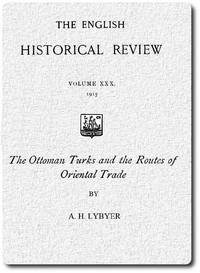Read this ebook for free! No credit card needed, absolutely nothing to pay.
Words: 9172 in 3 pages
This is an ebook sharing website. You can read the uploaded ebooks for free here. No credit cards needed, nothing to pay. If you want to own a digital copy of the ebook, or want to read offline with your favorite ebook-reader, then you can choose to buy and download the ebook.


: The Ottoman Turks and the Routes of Oriental Trade from The English Historical Review October 1915 by Lybyer Albert Howe - Commerce History; Turkey History; Trade routes
THE ENGLISH
HISTORICAL REVIEW
Within a period of a little more than two hundred years, from the close of the thirteenth century to the second decade of the sixteenth, the rising power of the Ottoman Turks extended the area of its political control until its holdings stretched north and south across the Levant from the Russian steppes to the Sudanese desert. The Turkish lands thus came to intercept all the great routes which in ancient and medieval times had borne the trade between East and West. Near the time when the Turkish control became complete, a new way was discovered, passing around Africa; and within a few years the larger part of the through trade between Europe and Asia had deserted the Levantine routes and begun to follow that round the Cape of Good Hope. The causes of this diversion of trade have not been fully agreed upon. No specific investigation of the subject appears to have been made. A glance through works which, being mainly concerned with other subjects, have alluded to the shifting of the routes of oriental trade about the year 1500, shows that two incompatible views are prevalent. One of these holds in general that the advance of the Ottoman power gradually blocked the ancient trade-routes and forced a series of attempts to discover new routes; after these attempts had succeeded, the Turks continued to obstruct the old routes and compelled the use of the new. The other view finds little or no connexion between the growth of the Turkish power and the causes of the great discoveries: a set of motives quite independent of the rise of the Turks led men like Henry of Portugal and Christopher Columbus to explore the unknown world; and when the new route to India had been established it was found to possess an essential superiority for trade, which gave it pre-eminence until in the nineteenth century the balance was again turned by the introduction of steam navigation and the opening of the Suez Canal. The evidence appears to be overwhelmingly in favour of the second of these views. In the present article, however, without arguing the question directly, it is proposed to survey the course of oriental trade from the close of the great Crusades until the eighteenth century, so as to show the influence of the Ottoman Turks as it emerged historically.
The medieval trade-routes between western Europe and eastern and southern Asia fall into two groups: the northern, which passed mainly by land, and the southern, which passed mainly by sea. The former communicated with central Asia, China, and India through the Black Sea and Asia Minor, the latter through Syria and Egypt. Each group had branches which entered Asia near Aleppo and diverged in the direction of Tabriz and Bagdad. On all routes there were what in America are compendiously termed 'long hauls' and 'short hauls'; that is to say, wares which travelled most of the way, as Western silver and coral and Eastern silk and spice, and wares which travelled only part of the way, as sugar, cotton, and Arabian gums. It was possible, also, for merchants who dealt in goods of the former class to travel the whole road or to go only part of it and sell or exchange their commodities, which would be carried on by other hands. For most goods the southern routes, especially that by the Red Sea, were cheaper, because they ran mostly by sea; but this consideration was less important in the case of the costlier spices, especially as they were liable to suffer damage in the holds of ships. It was not so much, however, the question of expense as political and religious conditions which determined what routes would be preferred. If merchants are hindered by one route, said Marino Sanuto the Elder, they find another, like water, and they never cease seeking a way which will bring them more profit.
At the beginning of the fourteenth century five routes were most in use: the land road through Tana from the mouth of the Don north of the Caspian Sea to China; the way through Trebizond to Tabriz and central Asia; the two roads from Lajazzo at the head of the Gulf of Alexandretta, one by Tabriz, the other by Bagdad and the Persian Gulf to India and beyond; and finally the route by the Nile, Kosseir, the Red Sea, and the Indian Ocean to southern and eastern Asia. The north road was practicable as far as China for the century between 1240 and 1340, while the Mongol Empire was strong. During this time foreign merchants, missionaries, and travellers were protected, and encouraged to traverse the vast Mongol territories freely. These were still pagan in 1291, though the western divisions turned Moslem soon after that date. The routes which entered at Trebizond and Lajazzo nourished the small Christian states of Trebizond and Lesser Armenia, which served as vestibules to the Mongol lands. Between them lay Asia Minor, the land of the Turk, broken at the time into ten small emirates, hostile in the interior to Christian strangers, but dealing freely at its ports with Western traders, and beginning to develop a commercial and piratical shipping. Palestine and Egypt were under the Mameluke sultans, who permitted no foreign Christian to cross their dominions, but who, as well as their subjects, derived great profit from a large trade between West and East. Christian cities, especially Venice, Genoa, and Barcelona, traded regularly at Alexandria.
The popes never forgave the Mamelukes for expelling Western Christians from the Holy Land, and after repeated efforts they succeeded in the second quarter of the fourteenth century in reducing Christian commerce with Alexandria to small proportions. Hence the trade by the other routes increased, and the prices of comparatively bulky Eastern wares like pepper and ginger became higher in the West. But the Mongol empire disintegrated rapidly, first into large states, then into a multitude of small ones which threatened anarchy. In consequence, from about the year 1340 the northern through route to China ceased to be practicable and the ways through Persia became difficult. This was the first obstruction, or rather breaking up, of the trade-routes, and in it the Ottoman Turks, who then formed a small though vigorous principality, had no part. But since all the Levantine routes were now restricted in one way or another, the Venetians and Genoese appealed to the pope for assistance; and a system of licences to trade with Egypt was developed, which in time restored the commerce of the southern route to its old prosperity. Subject to temporary fluctuations, spices became comparatively cheap, and the average price changed little, except for a slight fall, before 1520.
In 1356 the Ottoman Turks established themselves on both sides of the Dardanelles, and, though they had little shipping they were able to exercise some influence on the fraction of oriental trade which still passed through the Black Sea. They also gradually incorporated the other Turkish principalities in Asia Minor, and with them took over their trade agreement with Genoa and Venice and their rights to tribute from certain of the Aegean Islands. Meanwhile in 1375 the Mamelukes absorbed Lesser Armenia , and thus brought into their hands the outlets of the three southern routes, which they held unmolested for one hundred and forty years. But frequent internal troubles in Persia disturbed the commerce which passed through Syria, and a violent alteration of trade-routes was accomplished by Timur, who plundered Tana and seems to have checked the through trade from the East to the ports north of the Black Sea. He had definite commercial aims and made Samarkand a centre for caravans from China, India, Persia, and the West; but he accomplished no such permanent political or economic unification of his dominions as had the first Mongol emperors. At his death in 1405 Persia fell into worse anarchy than ever, and the northern routes of the oriental trade became as nearly completely blocked as they ever were. The Turks took no part in this process, though they suffered from it, both in Timur's time and afterwards.
Venice had by now beaten Genoa decisively, and there ensued a century of comparative stability in the oriental trade. Pearls, silk, pepper, ginger, nutmegs, mace, cinnamon, and cloves were steadily exchanged in Syria and Egypt against gold, silver, copper, lead, tin, coral, and the like. The Mameluke sultan and his subjects took toll of all, and Venice did most of the carrying and gained most of the profit. While the value of commodities was multiplied many times in the 'long hauls', it does not seem to be the case that Egypt and Venice took more than due advantage of the situation. Supply and demand have their effect even upon monopoly prices.
The commercial policy of the Turks, now well established, was not at all one of hostility to trade. They sought indeed to exclude foreigners from their internal commerce, as well as from the conduct of through trade while crossing their lands. But such a desire cannot rightly be counted against them; all states endeavour to protect the pockets of their subjects. In conquering new regions the Turks regularly renewed the old commercial treaties with foreign powers, and usually observed them faithfully. It is true that with them commerce was secondary, and conquest stood first. But they wished to encourage trade for the sake of revenue. They fought with Genoa and Venice, not because these were trading powers, but because they owned lands, cities, and exceptional rights within the area of Turkish political influence. With Florence, Ancona, and other commercial cities which had no lands in the Levant and strove for none relations were uniformly good. The Turks even confirmed or granted privileges of trade in their ports beyond what were allowed in the West, and some of their rules as regards duties were more liberal than elsewhere. But no doubt generous provisions were not infrequently frustrated in particular cases by grasping officials, who, by the way, were usually renegade Christians.
After his conquest of Trebizond Mohammed II came into conflict with Venice in 1464 and took some of her Levantine territory. War followed for nine years, in the course of which a new route of Eastern trade was temporarily opened. The Venetians formed an alliance, both military and commercial, with the Turkoman Uzun Hassan, and some regions of southern Asia Minor, which had not been recovered by the Ottoman Turks since the time of Timur, furnished an opening through which spices could pass for a short time to Satalia, the present Adalia. Mohammed, however, annexed the southern regions, inflicted a severe defeat upon Uzun Hassan, and forced the Venetians to a favourable peace. Soon after this he took the Genoese possession of Kaffa in the Crimea, subjugated the Tartars of that neighbourhood, and obtained complete control of the Black Sea. The trade to the East through that sea was already practically gone. Some Genoese remained in Kaffa, and the Venetians obtained sailing and trading rights which were continued formally for sixty years. But for about three centuries the Black Sea was used by hardly any other ships than those of the sultan's subjects. A considerable trade upon it supplied Constantinople with food and various raw materials, some of which were exported to the West. The conquests of Mohammed II undoubtedly contributed in some degree to the obstruction of the northern routes, but their importance, both in time and extent, was secondary. What measure of reduction they accomplished in the Levant trade at the north served to increase the trade along the southern routes, and we have seen that these conquests accomplished no discernible permanent elevation of prices in the West.
In the war of Bayezid II with the sultan of Egypt, during the years 1485 to 1491, caused by the latter's giving asylum to the former's brother, Prince Jem, the Turkish troops were thoroughly defeated. The course of oriental trade through Syria and Egypt was not in the least molested by the Turks before the year 1516. Along the northern routes, whose outlets were in their hands, they made no effort to stop the flow of wares. In times of peace and order in Persia many caravans passed east and west, exchanging wares from the Aegean Sea even to the far interior of Asia. There continued also a regular movement north and south to Aleppo, and thence to Bagdad and Mecca and the East. If the Turks had hindered oriental trade, they had checked it but slightly. During their frequent wars commerce was more or less disturbed; but the wars usually ended in an increase of territory which furnished a wider commercial opportunity.
Through Egypt and Syria, although disputes about the succession to the Mameluke throne, occasional visitations of the plague, and quarrels between natives and Europeans caused the volume of trade to fluctuate, the old flow of oriental wares was maintained unbroken down to 1502. That year marks a new epoch. The galleys of Venice found very few spices at Alexandria and Beirut; in 1504 they found none at all. The southern trade-routes of the Levant had been emptied by the purchases of the Portuguese in India. From that year an average of twelve or more ships left Lisbon annually for the East, and from 1507 the Portuguese sent fleets to blockade the mouths of the Red Sea and the Persian Gulf. It was a deliberate attempt to stop permanently the passage of wares along the old southern routes of oriental trade, made not by Turks but by western Europeans, but it was not entirely successful. The Venetian galleys which continued to sail to the Levant usually found some spices to be bought. But the old certainty was gone, and prices which were low at Lisbon were high at Beirut and Alexandria. The total quantity of spices which came by the old routes from the East to Europe was greatly reduced. Venice sent fewer ships to the Levant and deemed it imprudent to build new galleys for the Eastern trade. This was the situation when Selim I overthrew the Mameluke sultans in 1516 and 1517. Instead of blocking the southern routes further, he adopted the policy which the Mamelukes had left him. He renewed the old treaties with Venice and the West, and took over the intention of crushing the Portuguese naval power in the Indian Ocean by a fleet sent down the Red Sea.
Free books android app tbrJar TBR JAR Read Free books online gutenberg
More posts by @FreeBooks

: Heidelberg: A Romance. Volumes I II & III by James G P R George Payne Rainsford - Frederick I King of Bohemia 1596-1632 Fiction; Palatinate (Germany) History Frederick V 1610-1623 Fiction


: St. Paul's Epistles to the Colossians and Philemon A revised text with introductions notes and dissertations by Lightfoot J B Joseph Barber - Bible. Colossians Commentaries; Bible. Philemon Commentaries; Bible. Colossians Criticism interpretation etc.; Bi





